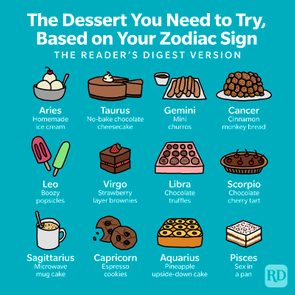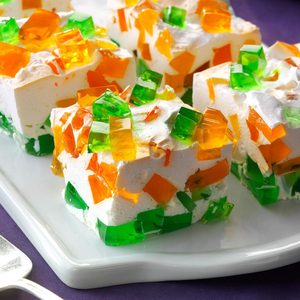Here’s the Real Reason You Always Have Room for Dessert, According to Science
The other night, I was out to dinner with friends, and we had just finished a feast. Plates were empty, pants were loosened and then—like an angel descending—our waiter rolled up with the dessert cart.
Before I could even start drooling, my friend waved him off. “No thanks, I’m still so full from dinner.”
The waiter and I both blinked. “What?” we blurted in unison.
OK, sure, what she said was logical. But to me, it was completely incomprehensible. I’ve always had a sweet tooth, and satiety has never had anything to do with it. If I do skip dessert, it’s not because I’m full—it’s because of sheer, white-knuckled willpower. And I know I’m definitely not alone.
So what gives? How do most of us always magically have room for dessert? Well, science has an answer, and it turns out it’s not magic. It’s your brain playing tricks on you (sort of). A new study published in the journal Science reveals exactly what happens in our bodies when our so-called “dessert stomach” kicks in, even when we’re not hungry. Read on to discover what the researchers found, along with a few expert tips for having your cake and eating it too.
Get Reader’s Digest’s Read Up newsletter for more news, humor, cleaning, travel, tech and fun facts all week long.
How was the study conducted?
To crack the code on why we always say yes to dessert, researchers turned to our tiny, furry, dessert-obsessed counterparts: mice. They fed the mice a full meal of mouse kibble, followed by either more bland mouse chow or a sugary mouse dessert (which, let’s be honest, sounds ridiculously adorable). The result? The mice who got dessert ate six times more calories than the ones stuck with extra mouse chow. Clearly, the sweet tooth is not bound by species.
To see if the same thing happens in humans, researchers fed people a sugary drink through a tube (which, unlike tiny mouse desserts, sounds deeply unappealing). While their test subjects sipped mystery sugar goop, scientists scanned their brains using fMRI to see if our brains act similarly. Spoiler alert: They do!
So why do we always have room for dessert?

Here’s the scientific lowdown: The culprit is a group of neurons called pro-opiomelanocortin (POMC) neurons, found in the brain’s arcuate nucleus—the same area that regulates hunger and fullness. Normally, these neurons signal that you’re full and should stop eating. But plot twist: When you’re stuffed, they suddenly switch gears and trigger sugar cravings instead. Essentially, this is proof that our love for dessert isn’t just about habit, taste or that inner voice whispering, “Treat yourself.” It’s biology.
Here’s the play-by-play of what’s happening in your brain: First, POMC neurons control fullness, telling you when to stop eating. But once you’re full, instead of just shutting down hunger, these neurons activate an opioid response in the brain. This opioid release dials up your sugar cravings to 11, making dessert suddenly seem essential.
Mir Ali, MD, a bariatric surgeon based in California who was not involved in the study, explains that this creates a vicious cycle because “sugar actually relaxes the stomach, increasing its capacity.” As a result, not only do you crave dessert but your stomach also physically accommodates more of it, making it even easier to overindulge. And in the end, he adds, “it’s a combination of physiology and psychology. We’re mentally conditioned to want something sweet after a meal, but it’s not just mental, there are physiological changes occurring in your brain and body.”
What do other studies say?
This Science study aligns with previous research showing that sugar affects the brain differently than other types of food. For instance, sugar overrides fullness signals, according to a study in Cell Metabolism published in 2019. Researchers found that sugar affects our dopamine system, making us want more—even when we’re full.
Dessert is also a different category to our brains. Research published in Appetite in 2018 confirmed that people who were too full for more of their main course still made room for sweets.
Lastly, research published in the book Flavor-Associated Applications in Health and Wellness Food Products says that certain foods, particularly those high in fat, sugar and salt (aka all the best dessert ingredients), can override satiety signals in the brain, leading to continued consumption despite being full.
Is there a way to beat dessert cravings?
If your brain is pushing you toward dessert even when you’re full, you can try these strategies from Dr. Ali to outsmart your cravings:
- Order fruit instead. “Fruit still has sugar, but it has a lot less of it and therefore less calories,” Dr. Ali says. “It also comes with fiber, which will slow down digestion.”
- Take a short walk. “This increases your glucose metabolism and reduces cravings, and by changing the scenery, it may help you put dessert out of your mind,” Dr. Ali explains.
- Wait 10 minutes. Often, cravings pass if you give yourself time to digest and let satiety signals catch up. This is a good habit to get into, whether you’re home or at a restaurant.
- Drink water or tea. A warm drink can help your brain signal that the meal is over.
- Brush your teeth. Minty flavors can suppress the urge for something sweet. Plus, if you do still reach for the sweet stuff after brushing, it might taste weird when combined with the toothpaste taste, so you might not want it in the end.
- Share a dessert. If you can’t resist, split it with a friend to enjoy the taste without overindulging. As with so many other things in life, a little can go a long way.
- Skip processed desserts. Some artificial colors, flavors, preservatives and sweeteners have been linked to increased consumption. Plus, overly processed foods are often higher in calories. Instead, go for a homemade dessert or something that’s minimally processed.
- Indulge on occasion! Depriving yourself completely can lead to stronger cravings later. “Just be mindful of portion control,” Dr. Ali says.
About the expert
|
Why trust us
At Reader’s Digest, we’re committed to producing high-quality content by writers with expertise and experience in their field in consultation with relevant, qualified experts. We rely on reputable primary sources, including government and professional organizations and academic institutions as well as our writers’ personal experiences where appropriate. We verify all facts and data, back them with credible sourcing and revisit them over time to ensure they remain accurate and up to date. Read more about our team, our contributors and our editorial policies.
Sources:
- Science: “Thalamic opioids from POMC satiety neurons switch on sugar appetite”
- Mir Ali, MD, board certified general surgeon, bariatric surgeon and medical director of MemorialCare Surgical Weight Loss Center at Orange Coast Medical Center in Fountain Valley, CA; phone interview, March 20, 2025
- Cell Metabolism: “Food Intake Recruits Orosensory and Post-ingestive Dopaminergic Circuits to Affect Eating Desire in Humans”
- Appetite: “Expected satiation alone does not predict actual intake of desserts”
- Flavor-Associated Applications in Health and Wellness Food Products: “Satiety Sensation and Its Associated Food Compositions and Flavors”
The post Here’s the Real Reason You <i> Always </i> Have Room for Dessert, According to Science appeared first on Reader's Digest.
from Reader's Digest https://ift.tt/1ZlnuHv



Comments
Post a Comment